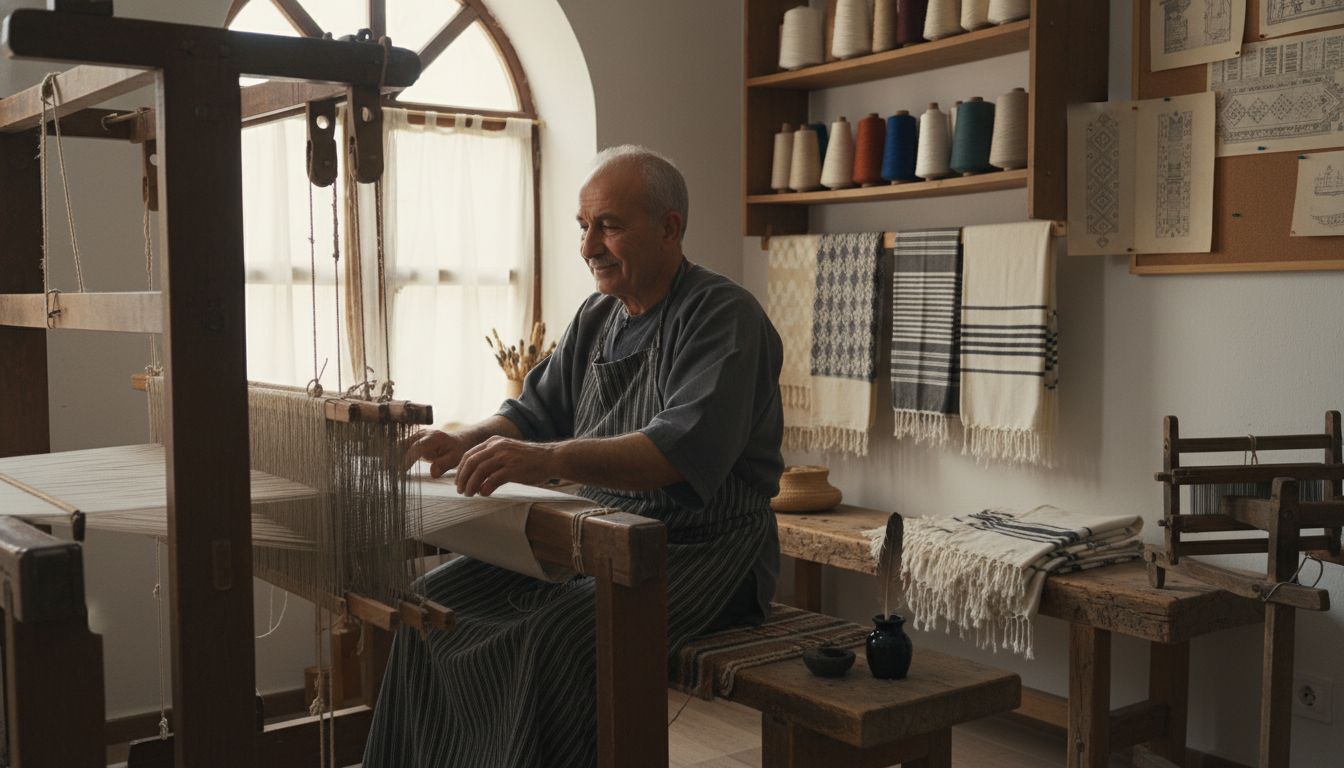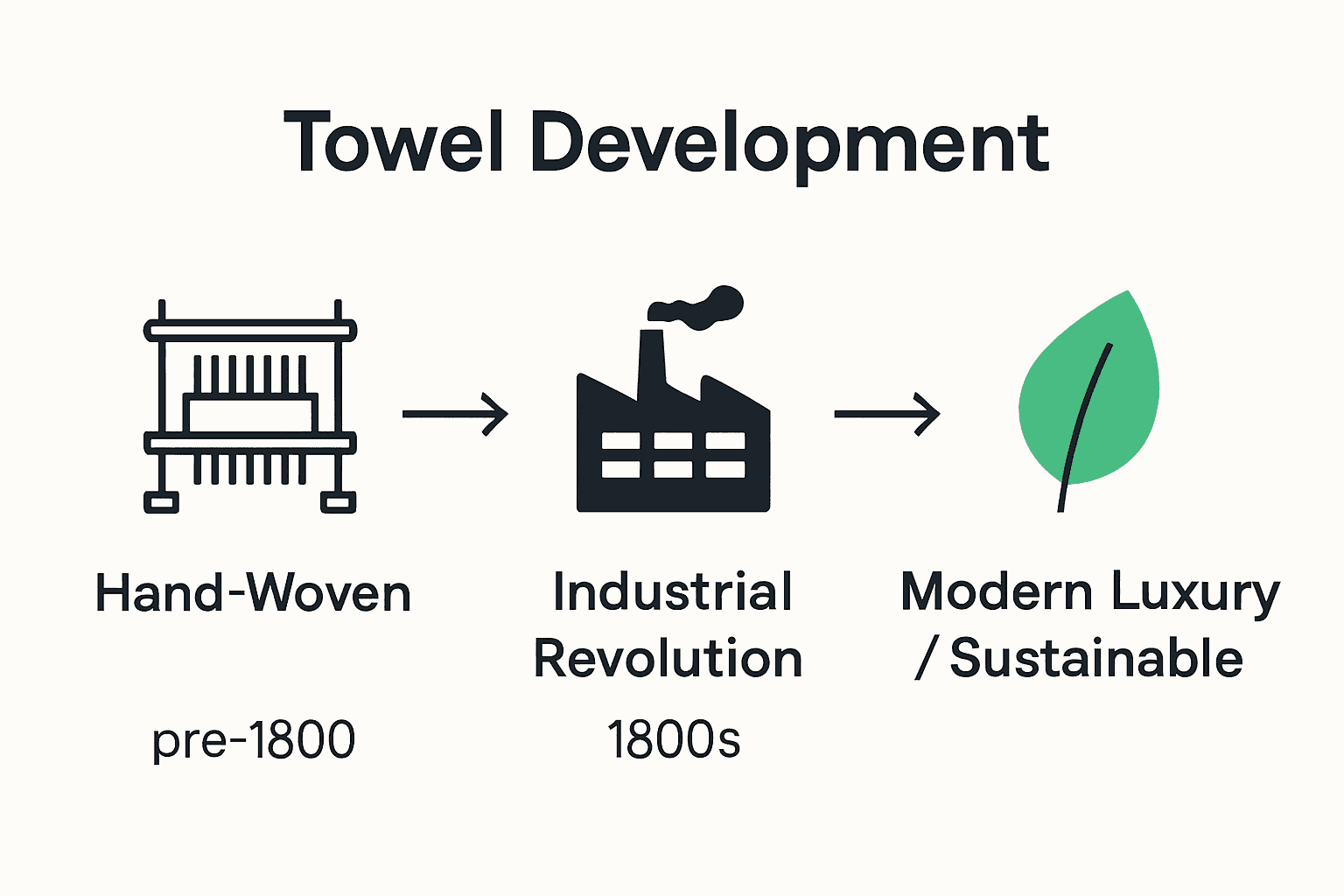Over centuries, the humble towel has been so much more than just a way to get dry. From Medieval Europe, where people carried towels as prized possessions, to the dazzling rituals of Ottoman bathhouses, these textiles reveal a blend of comfort, social status, and artistry. Early towels were often hand-woven with intricate skill, reflecting care and cultural meaning. Discover how towels have shaped hygiene, tradition, and luxury from ancient history to modern homes.
Table of Contents
- Defining Towel Origin: Early Beginnings
- Historical Towel Types And Early Uses
- Cultural Significance Across Civilizations
- Industrial Revolution And Towel Innovations
- Modern Luxury Towels And Trends
Key Takeaways
| Point | Details |
|---|---|
| Historical Significance | Towels evolved from simple utilitarian items to culturally significant artifacts reflecting hygiene, social status, and personal care across civilizations. |
| Cultural Diversity | Different regions developed unique towel types, with purposes extending beyond drying to embody social rituals and artistic expression. |
| Industrial Transformation | The Industrial Revolution made towels more accessible, leading to innovations like terry-toweling and disposable paper towels that enhanced functionality and variety. |
| Modern Trends | Today’s luxury towels emphasize performance and aesthetics, with a focus on sustainable materials, personalization, and enhancing contemporary lifestyles. |
Defining Towel Origin: Early Beginnings
The story of towels is a fascinating journey through human hygiene and cultural practices. According to Wikipedia, the very word ‘towel’ has deep linguistic roots, originating from the Old French term ‘toaille,’ which can be traced back to the Frankish word ‘þwahli,’ meaning ‘washing’ or ‘wiping.’ This etymological exploration reveals how intrinsically linked towels are to the fundamental human need for cleanliness.
Historical evidence suggests that towels were not merely functional items but deeply personal possessions. In the Middle Ages, individuals would carry towels alongside their knives as essential personal belongings, highlighting the significant role these textiles played in daily life. Turkish Towels provide another fascinating perspective, showcasing how towel evolution was deeply connected to cultural bathing practices. In Anatolia, peshtemal towels emerged from sophisticated bathing traditions, transitioning from simple flat-woven cotton or linen pieces to integral components of communal bathing rituals in Ottoman hammams.
The transformation of towels reflects more than just textile development - it represents a profound narrative of human comfort, privacy, and personal care. From the Roman thermae to medieval European households and Ottoman bathing cultures, towels have consistently been more than mere fabric. They were symbols of cleanliness, social status, and personal hygiene. These early towels were carefully crafted, often hand-woven with intricate techniques that spoke to the craftsmanship of their creators.

As civilizations developed, so did towel design and functionality. What began as simple washing cloths gradually evolved into specialized textiles designed for specific purposes - from personal drying to communal bathing, from luxury item to everyday necessity. Learn more about modern towel choices in our guide on how to choose bath towels, which explores how these ancient traditions continue to influence contemporary textile design.
Historical Towel Types and Early Uses
The evolution of towels reveals a remarkable diversity of cultural adaptations across different civilizations. According to Wikipedia, early towel types were far more than simple drying tools - they were multifunctional textiles deeply embedded in social practices. The peshtemal from Turkey, for instance, emerged as a lightweight and highly absorbent fabric specifically designed for hammam (public bath) use, showcasing how towels were intricately linked to bathing rituals.
In Mediterranean regions and Yemen, the fouta represented another fascinating example of textile innovation. Wikipedia describes the fouta as a thin, patterned cotton or linen fabric that transcended its basic functional role. These versatile textiles were worn by both men and women in public baths, serving simultaneously as a wrap and a towel. This dual-purpose design highlighted the practical ingenuity of ancient textile makers who created items that maximized utility and adaptability.
Geographical variations in towel design reflected unique cultural needs and environmental conditions. In Japan, the tenugui emerged as a remarkably versatile cloth used for drying, decoration, and even as a fashion accessory. These regional distinctions demonstrate how towels were not merely utilitarian items but complex cultural artifacts that embodied local craftsmanship, aesthetic sensibilities, and social practices.
As textile technologies advanced, these early towel types gradually transformed. What began as simple, multipurpose cloths evolved into specialized fabrics designed for specific purposes. Learn more about modern textile innovations in our guide to terry cloth, which explores how ancient weaving techniques continue to influence contemporary towel design and functionality.
Cultural Significance Across Civilizations
Towels have transcended their basic functional purpose, emerging as powerful symbols of cultural identity, spiritual practices, and social rituals across diverse civilizations. Lola App reveals fascinating insights into how different cultures have imbued these seemingly simple textiles with profound meaning and significance.
In India, towels are not merely cleaning tools but sacred objects of deep symbolic importance. During religious ceremonies and weddings, they are exchanged as powerful tokens of unity, purity, and mutual respect. The Japanese tea ceremony provides another remarkable example of towel significance, where the tenugui is used with meticulous care, representing principles of cleanliness, mindfulness, and profound cultural etiquette. These rituals demonstrate how towels function far beyond their practical utility, serving as conduits of cultural expression and spiritual connection.
Indigenous cultures have also developed unique relationships with textiles. Native American traditions, for instance, use towels to wrap sacred objects, transforming them from mere cloths into repositories of spiritual energy and cultural memory. This practice underscores how textiles can be vessels of ancestral wisdom, carrying stories and spiritual significance that extend far beyond their physical form.
The cultural journey of towels reflects humanity’s remarkable ability to invest everyday objects with deep emotional and spiritual meaning. Explore the intricate world of textile traditions in our bathrobe history guide, which delves into how clothing and textile practices reveal the rich tapestry of human cultural experience.
Industrial Revolution and Towel Innovations
The Industrial Revolution fundamentally transformed the textile industry, particularly the production of towels. According to Wikipedia, mechanization and the expanding cotton trade made towels dramatically more accessible and affordable for the average consumer. The introduction of cotton terry-toweling represented a significant breakthrough, allowing manufacturers to produce towels by the yard and as pre-made products with unprecedented variety in sizes, materials, and designs.
Technological innovations dramatically expanded towel functionality and consumer choices. A remarkable milestone came in 1965 when Wikipedia notes that Procter & Gamble introduced Bounty, a revolutionary two-ply paper towel that was significantly thicker, softer, and more absorbent than existing products. This innovation marked a pivotal moment in disposable towel technology, demonstrating how industrial advancements could transform everyday household items.
The mechanization of textile production democratized access to high-quality towels. What was once a luxury item became a standard household necessity, with manufacturers experimenting with different weaving techniques, materials, and designs. The emergence of industrial production meant that consumers could now choose from a wide range of towels tailored to specific needs - from heavy-duty cleaning cloths to delicate, soft bathroom linens.

As textile technologies continued to evolve, towel design became increasingly sophisticated. Discover the latest trends in modern loungewear with our guide to men’s robe styles, which explores how industrial innovations continue to shape textile design and consumer preferences.
Modern Luxury Towels and Trends
Modern luxury towels have transformed from simple functional items to sophisticated lifestyle accessories that blend advanced textile technology with aesthetic design. Today’s discerning consumers seek towels that not only dry effectively but also enhance their personal spaces, reflecting individual style and commitment to comfort.
Contemporary luxury towels distinguish themselves through innovative materials and design philosophies. High-performance fabrics like Egyptian cotton, bamboo blends, and microfiber have revolutionized towel experiences, offering superior absorption, quick-drying capabilities, and exceptional softness. Manufacturers now focus on creating towels that are not just practical but also sensory experiences - with refined textures, elegant color palettes, and sophisticated weaving techniques that elevate everyday routines.
The personalization trend has significantly impacted luxury towel design, with consumers seeking unique, customizable options that reflect their individual preferences. From monogrammed designs to custom color selections, towels have become personal statements of style and sophistication. Sustainability has also emerged as a crucial factor, with eco-conscious consumers demanding towels produced using environmentally responsible methods and organic materials.
Explore our curated selection of luxury bathroom inspirations to understand how modern towel design integrates seamlessly with contemporary interior aesthetics, transforming bathrooms from mere functional spaces into personal sanctuaries of comfort and style.
Discover the Timeless Comfort of Towels Rooted in History
Understanding the rich history of towels reveals more than just their origins it highlights the deep human desire for comfort and cleanliness that persists today. If you have ever struggled to find towels that combine tradition with modern luxury you are not alone. The article traces how towels evolved from simple cloths in ancient cultures to sophisticated textiles designed for ultimate softness and absorbency. Today the challenge is choosing towels that honor this heritage while meeting your everyday needs for durability and style.
Explore premium options like the Scallop Piping Towel Set | Lotus Linen which balances classic craftsmanship with plush comfort.

Experience towels that celebrate centuries of textile evolution and bring luxury into your home now. Visit Lotus Linen to find collections that embody this tradition or enhance your relaxation with our Luxury & Affordable Waffle Bathrobes for Men | Lotus Linen. Don’t wait to elevate your daily routine with quality and style inspired by history.
Frequently Asked Questions
What is the historical significance of towels in human culture?
Towels have played a crucial role throughout history, serving as both functional items for cleanliness and personal possessions that reflect social status and cultural practices. From communal bathing rituals to individual care, towels have evolved alongside human hygiene needs.
How did the Industrial Revolution impact towel production?
The Industrial Revolution revolutionized towel production by introducing mechanization and mass production techniques. This made towels more accessible and affordable, transforming them from luxury items into everyday necessities with a variety of sizes, materials, and designs.
What are some unique types of towels developed in different cultures?
Various cultures have developed unique towel types, such as the peshtemal used in hammams, the fouta worn as both a wrap and towel, and the tenugui used in Japanese tea ceremonies, illustrating how towels serve multifunctional roles within cultural practices.
What trends are currently shaping modern towel design?
Modern towel design trends emphasize luxury, sustainability, and personalization. Today’s consumers seek high-performance fabrics, customizable options, and eco-friendly production methods that align with their individual styles and commitment to sustainability.
